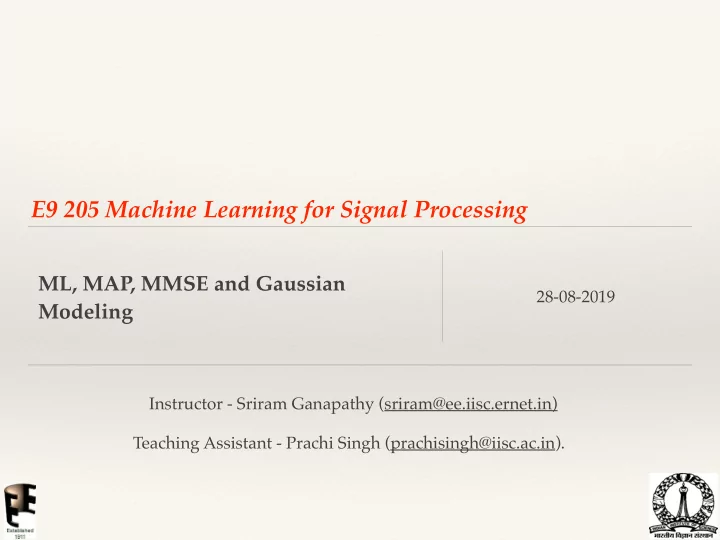

E9 205 Machine Learning for Signal Processing ML, MAP, MMSE and Gaussian 28-08-2019 Modeling Instructor - Sriram Ganapathy (sriram@ee.iisc.ernet.in) Teaching Assistant - Prachi Singh (prachisingh@iisc.ac.in).
Decision Theory (PRML Chap. 1.5) ❖ Decision Theory ❖ Inference problem ❖ Finding the joint density ❖ Decision problem ❖ Using the inference to make the classification or regression decision
Decision Problem - Classification ❖ Minimizing the mis-classification error ❖ Decision based on maximum posteriors ❖ Loss matrix ❖ Minimizing the expected loss
Visualizing the Max. Posterior Classifier
Approaches for Inference and Decision I. Finding the joint density from the data. II. Finding the posteriors directly. III. Using discriminant functions for classification.
Approaches for Inference and Decision I. Finding the joint density from the data. II. Finding the posteriors directly. III. Using discriminant functions for classification.
Advantage of Posteriors
Decision Rule for Regression ❖ Minimum mean square error loss ❖ Solution is conditional expectation.
Generative Modeling Non- parametric Generative Classifiers Parametric
Non-parametric Modeling • Non-parametric models do not specify an apriori set of parameters to model the distribution. Example - Histogram # 10 4 3 2.5 2 Bin Count 1.5 1 0.5 0 -0.25 -0.2 -0.15 -0.1 -0.05 0 0.05 0.1 0.15 0.2 0.25 Sample value The density is not smooth and has block like shape.
Non-parametric Modeling • Non-parametric models do not specify an apriori set of parameters to model the distribution. • Example - Kernel Density Estimators Histogram Kernel Density Kernel is a smooth function which obeys certain properties
Non-parametric Modeling • Non-parametric methods are dependent on number of data points • Estimation is difficult for large datasets. • Likelihood computation and model comparisons are hard. • Limited use in classifiers
Parametric Models (Chap 2 PRML) ❖ Collection of probability distributions which are described by a finite dimensional parameter set • Examples - • Poisson Distribution • Bernoulli Distribution • Gaussian Distribution
Gaussian Distribution One of most widely used and well studied model Points of equal probability lie on on contour Diagonal Gaussian with Identical Variance
Gaussian Distribution Insights into two dimensional Gaussian distribution Diagonal Gaussian with different variance
Gaussian Distribution Insights into two dimensional Gaussian Distribution Full covariance Gaussian distribution
Gaussian Distribution Fitting the data with a Gaussian Model
Finding the parameters of the Model ❖ The Gaussian model has the following parameters ❖ Total number of parameters to be learned for D dimensional data is ❖ Given N data points how do we estimate the parameters of model. ❖ Several criteria can be used ❖ The most popular method is the maximum likelihood estimation (MLE).
MLE Define the likelihood function as The maximum likelihood estimator (MLE) is The MLE satisfies nice properties like - Consistency (covergence to true value) - Efficiency (has the least Mean squared error).
MLE For the Gaussian distribution To estimate the parameters
Recommend
More recommend